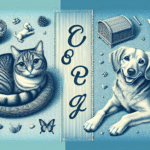A Wickedly Safe Halloween: The Complete Pet Parent’s Guide to a Fun, Fear‑Free Night
Halloween is a favorite for many of us — crisp air, creativity on full display, and a parade of miniature superheroes, witches, and dinosaurs. For our pets, though, the very things that make the holiday fun for people can be confusing, startling, and sometimes risky. Costumes feel strange. Doorbells ring a dozen times an hour. Candy hides in every corner. And unfamiliar decorations flicker and glow.
Good news: With a little planning and a few savvy tweaks, you can keep the spooks solely in the decorations and give your dog or cat a calm, safe, and even delightful Halloween. This guide brings together expert advice and real-world tips to help you prepare, prevent problems, and enjoy the night — without any fur-raising frights.
Below, you’ll find practical strategies for costumes, candy, guests, walks, parties, and more, plus seasonal reminders for cold weather and emergency readiness. Whether you’re hosting, handing out treats, or heading out, these tips will help you tailor Halloween to your pet’s needs.
Why Halloween Feels So Different to Pets
Pets thrive on predictability. Halloween is the exact opposite: new smells (makeup, fog machines, scented candles), new sights (large yard inflatables, unusual silhouettes), and new sounds (doorbells, excited kids, spooky music). Even the most social animals can feel unsettled by the sheer volume of novel stimuli in a short window of time. That doesn’t mean your pet has to miss out — it just means we set them up for success, intentionally and kindly.
Costumes: Comfort Before Cute
We love a good pet costume photo. But not every pet enjoys wearing clothing, and uncomfortable outfits can lead to stress, restricted movement, or even injury. The safest approach is to keep things simple and stress-free.
- Start small: Instead of elaborate multi-piece costumes, opt for a festive bandana, a themed collar, or a soft T-shirt. These are easier to tolerate and less likely to snag, trip, or frighten your pet.
- Fit matters more than flair: Any clothing should allow full movement, natural breathing, and unobstructed vision and hearing. Check that nothing is tight around the neck, chest, or armpits and that your pet can potty normally.
- Practice days before Halloween: Introduce new items like you would a harness. Leave them out for sniffing, pair them with treats, and do short dress-up sessions (60–120 seconds) with lots of praise. End sessions before your pet gets fidgety so they associate the costume with positive experiences.
- Skip small parts and dangly bits: Beads, bells, buttons, and small attachments can be chewed off and swallowed. Glitter and loose feathers can irritate eyes and throats.
- Supervise at all times: Never leave a costumed pet unattended. If you see pawing at the outfit, pinned-back ears, rigid posture, or tail tucked low, remove the clothing and pivot to a simple accessory instead.
- Photo tip: Snap pics early, before the doorbell chaos starts. Keep sessions brief and reward with a favorite snack or game.
The bottom line: Comfortable pets photograph better and have more fun. If your pet says “no thanks” to dress-up, honor that boundary and celebrate with themed toys, a special treat, or a Halloween walk at sunset.
Candy and Treats: What’s Safe, What’s Scary
Candy is everywhere on Halloween, but most “people treats” are a poor (and sometimes dangerous) choice for pets. Understanding the risks — and planning where the candy lives — goes a long way toward keeping your curious companion safe.
- Keep these out of paw’s reach: Chocolate (especially dark and baking chocolate) can cause vomiting, agitation, rapid heart rate, and seizures. Sugar-free candies and gums often contain xylitol (also listed as birch sugar), which can cause severe low blood sugar and liver failure. Grapes and raisins are toxic to dogs and can lead to kidney failure. Macadamia nuts can cause weakness and tremors in dogs. Hard candies and lollipops are choking hazards, and wrappers can cause intestinal blockages.
- Don’t forget “edibles” and alcohol: THC edibles are extremely dangerous to pets. Keep them locked away with alcohol and vape liquids. Even small amounts can lead to disorientation, incoordination, and serious illness.
- Contain the candy chaos: Designate a single, lidded container for the household haul and store it in a high cabinet. If you’re handing out candy, consider setting a sealed container on a porch table to reduce the back-and-forth to your door.
- Offer safe pet treats: Keep a bowl of your pet’s favorite treats by the door to reinforce calm behavior and include your pet in the festivities. You can also make simple pet-friendly goodies, like frozen pumpkin-and-yogurt cubes for dogs or a lick mat smeared with a pet-safe spread.
- What to do if your pet eats something risky: Don’t wait for symptoms. Note what was eaten and approximately how much, then call your veterinarian, the ASPCA Animal Poison Control Center at 888-426-4435 (fees may apply), or the Pet Poison Helpline at 855-764-7661. Do not induce vomiting unless a professional specifically instructs you to do so.
Door Dings and Ghoulish Guests: Managing the Front-of-House Frenzy
Repeated knocking and doorbells can ratchet up stress and create escape risks. Even confident dogs and cats can bolt when startled. A few environment tweaks can turn your entryway from chaotic to calm.
- Set up a “fright-free zone”: Choose a quiet room far from the door. Add familiar bedding, favorite toys, water, and a long-lasting food puzzle or chew. Consider white noise, soft music, or a TV to buffer outside sounds.
- Use barriers: Baby gates, closed interior doors, and playpens create layers of safety between pets and the open front door. For dogs, a dragline (a lightweight leash attached and trailing under supervision) can give you faster control if needed.
- Try a porch station: If local rules allow, set up a small table with treats outside so you can greet trick-or-treaters outdoors and keep your front door closed. A friendly sign like “Sleeping dog — please help yourself!” can be surprisingly effective.
- Protect the ID: Make sure dogs wear a collar with current tags and cats wear a breakaway collar with ID. Check that microchip details are up to date in the registry. Consider a pet GPS tracker if your pet is an escape artist.
- Train the “safe spot” cue: In the days leading up to Halloween, practice sending your dog to a mat or bed for a treat every time the doorbell rings (you can play a doorbell sound on your phone). This teaches “doorbell means go settle, not sprint to the door.”
Parties and Decorations: Hidden Hazards You Might Not Expect
Holiday ambiance can introduce unfamiliar hazards. A quick safety scan before the big night can prevent accidents and a late-night emergency vet visit.
- Cords and batteries: Secure electrical cords from lights and inflatables. Chewed batteries (including button batteries) can cause severe burns.
- Glow sticks and costume makeup: Ingredients in glow products can cause drooling, foaming, and GI upset if chewed — especially in cats. Store glow sticks and bracelets out of reach and promptly discard used items. Costume makeup and adhesives can also irritate skin and eyes or cause stomach upset.
- Open flames and dry ice: Candles in pumpkins are charming but risky around wagging tails. Switch to LED candles. Dry ice can cause burns and breathing issues — skip it in homes with pets.
- Small decor and fake cobwebs: Tiny spiders, beads, faux cobwebs, and tinsel-like materials can be choking or entanglement hazards and are particularly problematic if swallowed. Place decorations above nose level.
- Food and drink safety: During gatherings, keep alcohol, punch bowls, and snack platters out of reach. Chocolate desserts, toothpicks, and skewers can all be dangerous. Provide lidded trash cans to reduce scavenging.
- Strong scents and essential oils: Diffusers and aerosols can irritate airways, especially in cats and brachycephalic (flat-faced) dog breeds. Choose unscented candles and keep oils locked away.
Spooky Strolls: Reimagining the Halloween Walk
If your routine involves an evening walk, consider a Halloween day adjustment. Streets can be crowded, loud, and full of surprises after dusk.
- Walk before dark: Head out earlier, while it’s still light. Costumes, yard props, and inflatables are less startling when your pet can see them clearly.
- Pick a quieter path: Choose side streets or a park away from trick-or-treat traffic. If your dog is fearful, a play session at home can substitute for the walk on this one night.
- Gear up for visibility: Use a well-fitted harness, a non-retractable leash, and reflective or LED collars. Clip ID tags securely. Carry high-value treats to reward calm behavior and redirect attention from scary sights.
- Practice “let’s go” and “watch me”: Before Halloween, teach “let’s go” to turn away from triggers and “watch me” to maintain focus. On the night, keep sessions short and positive, and step away from anything your pet finds unsettling.
- For cats: Halloween is a great night to skip leash training or outdoor time. Offer indoor enrichment instead: window perches, wand toys, food puzzles, or a cardboard “haunted house” fort.
Calming Strategies for Anxious Pets
Some pets need extra support around novel events like Halloween. Consider a layered approach that uses training, environment, and, if necessary, veterinary guidance.
- Desensitize the doorbell: In the days prior, play a recording at low volume and pair it with a tossed treat to a bed or mat. Gradually raise the volume. Keep sessions short and upbeat.
- Provide “jobs” during peak hours: Stuffed frozen Kongs, lick mats, snuffle mats, or simple puzzle feeders can keep noses busy while the doorbell rings. Chewing and licking are naturally calming behaviors for dogs.
- Try calming aids: Some pets benefit from pheromone diffusers or collars, pressure wraps, or veterinarian-recommended supplements. Always discuss medications with your vet in advance — don’t wait until the afternoon of Halloween to ask about prescriptions.
- Mind your energy too: Pets read our body language. Keep your voice relaxed, move deliberately, and avoid fussing over signs of fear — redirect with a cue, reward calm, and provide quiet companionship.
If the Worst Happens: Your Lost Pet Action Plan
Despite best efforts, doors open and pets can slip out. Preparing ahead of time can speed up reunions.
- Before Halloween: Verify your microchip contact info. Make sure tags are legible. Snap a recent, clear photo showing your pet’s face and full body.
- If your pet gets out: Search immediately and methodically. Bring a leash, treats, and a favorite squeaky toy. Notify neighbors, local shelters, and animal control. Post on local lost-and-found pet groups and community forums. Leave a familiar bed or an item with your scent near the point last seen, and keep checking quietly at dawn and dusk.
Seasonal Bonus: Cold-Weather Prep as Fall Turns to Winter
Halloween often ushers in colder weather. As the temperature drops, a few simple habits help keep pets healthy and comfortable.
- Indoors is safest: Short-coated, senior, and very young pets are especially vulnerable to cold. Limit unsupervised outdoor time and consider a cozy sweater or coat for short-haired dogs on walks.
- Fuel and hydration: Pets that spend time outside may burn more energy keeping warm. Speak with your vet about appropriate caloric needs. Check water bowls often to ensure water is fresh and unfrozen. Use plastic bowls instead of metal to avoid tongues sticking in freezing weather.
- Paw protection: Ice-melting salts and de-icers can irritate paw pads. Rinse or wipe paws after walks and consider booties if you’ll be out on treated sidewalks. Pet-safe ice melt is available if you treat your own walkway.
- Hidden hitchhikers: Cats and small wildlife may seek warmth under car hoods. Bang on your hood or honk briefly before starting your engine.
- Antifreeze alert: Traditional ethylene glycol antifreeze is sweet-tasting and extremely toxic. Immediately wipe up spills and store all chemicals securely. Products with propylene glycol are less toxic but still require careful handling.
- Wind chill matters: Even when temperatures seem “not that bad,” wind can dangerously lower effective temperature. Provide a dry, draft-free shelter if your dog must be outdoors briefly and bring them back in promptly.
- Community cats: If you care for outdoor cats, set up insulated shelters and provide unfrozen water and calorie-dense food. Simple DIY shelters made from totes or foam coolers can make a lifesaving difference.
Disaster Readiness: Build a Grab-and-Go Pet Kit
Storms, power outages, and evacuations don’t wait for convenient timing. Assemble a pet emergency kit now so it’s ready whether the “emergency” is a storm or an unexpected late-night vet visit after Halloween.
- Identification and records: Copies of vaccination and medical records, plus your veterinarian’s contact details. Include microchip number and registry info. Keep digital copies in your phone and an extra set in a waterproof pouch.
- Medications and prescriptions: A week’s supply (minimum) of any daily meds, with dosage instructions. Check expiration dates monthly.
- Collars, harnesses, and leashes: Pack spares sized correctly for each pet. For cats, include a breakaway collar.
- Labeled carrier: A sturdy, covered carrier or crate for each pet. Label it with your name, phone, and an out-of-area emergency contact.
- Food and water: A 5–7 day supply of pet food (and a can opener if needed). Bottled water and collapsible or lightweight bowls.
- Litter and cleanup: Litter, a small litter box for cats, waste bags, paper towels, and sanitizer.
- Comfort items: A familiar blanket, a small toy, and a recent photo of you with your pet (useful for identification and proof of ownership).
- First-aid essentials: Gauze, non-stick bandages, adhesive tape, saline eyewash, tweezers, digital thermometer, styptic powder, and a pet-safe antiseptic. Add a printed basic first-aid guide.
- Behavior tools: A muzzle sized for your dog (even gentle dogs can bite when in pain) and pheromone wipes or sprays to help ease stress.
- Where to go: A short list of pet-friendly hotels and boarding options outside your immediate area, plus contact info for local shelters that may open pet-friendly spaces during disasters.
Store your kit in an easily accessible location and review its contents at the start of each season. Being prepared is a gift to your pet and peace of mind for you.
Adopting, Fostering, and Supporting Shelters During the Holidays
Halloween kicks off a stretch of busy holidays for shelters. As families travel or shift schedules, more pets may need temporary care, and shelters can get crowded. The kindness we extend at the front door on Halloween night can continue in the community year-round.
- Foster: Even a short-term foster stay (a weekend, a week) can make space for another pet in need and give an animal a break from the stress of a shelter. Foster families are especially helpful during holidays, when kennels fill and staffing is stretched.
- Adopt thoughtfully: If you’re considering adding a pet to your family, work with a reputable shelter or rescue. Ask about the animal’s needs and personality, and plan introductions at a calm time — not during a party or event — so your new pet can settle in peacefully.
- Advocate and volunteer: Offer to walk dogs, socialize cats, or help with adoption events. Many shelters host fall fundraisers, community vaccine or microchip clinics, and pet-supply drives. Your time and voice make a tangible difference.
- Donate supplies: Peanut butter, canned pumpkin, puzzle toys, soft treats, and chew items can help staff keep shelter dogs calm on high-stimulation nights like Halloween. For cats, donate hideaway beds, wand toys, and cardboard scratchers.
Across the country, shelters and rescues are working toward a future where every pet that can be saved is saved. Community support — fostering, adopting, donating, and spreading accurate pet-care information — is how we get there together.
Halloween Week Game Plan: A Simple Timeline
A little structure reduces last-minute stress. Here’s a straightforward plan you can tailor to your household.
- One week out: Confirm microchip info and ID tags; test-fit harnesses and collars. Introduce any costume items with short, positive sessions. Order extra treats, puzzle toys, and calming aids if needed.
- Three days out: Set up the safe room and practice doorbell-to-mat games. Gather candy into a sealed container and choose a porch or entry setup that minimizes door openings. Put emergency contacts (vet and poison control) on your fridge and in your phone.
- Day before: Pre-stuff Kongs, lick mats, and puzzles; chill or freeze them to increase duration. Confirm that glow sticks, candles, alcohol, and edibles are stored out of reach. Walk your dog along an alternative route to build familiarity for the big night.
- Halloween day: Exercise your dog earlier to help take the edge off. Feed a little early, provide enrichment in the safe room, and start calm background noise before the first trick-or-treaters arrive. Keep leashes and treats near the door for quick control and reinforcement.
- Night-of adjustments: If your pet is struggling despite prep, pivot. Turn off the porch light, leave a treat bowl outside with a note, and move to a quieter activity. Your pet’s well-being trumps tradition.
Quick Checklist: Halloween Pet Safety at a Glance
- Choose comfort-first costumes or simple accessories; supervise at all times.
- Store all candy in a single, sealed container away from pets.
- Know the danger list: chocolate, xylitol, raisins/grapes, hard candies and wrappers, macadamia nuts, alcohol, THC edibles.
- Set up a quiet safe room with familiar comforts and enrichment.
- Use barriers and keep IDs current; verify microchip info.
- Walk earlier, pick quieter routes, and use reflective/LED gear.
- Secure cords, skip open flames, and remove small/dangly decor.
- Have vet and poison control numbers handy: ASPCA 888-426-4435; Pet Poison Helpline 855-764-7661.
- Prepare a pet emergency kit and review cold-weather safety basics.
- Support your local shelter: foster, adopt, volunteer, or donate supplies.
Frequently Asked “What Ifs”
- What if my dog eats a tiny piece of chocolate? Effects depend on the type and amount of chocolate and your dog’s size. Call your vet or a poison control hotline with the specifics. Don’t rely on internet calculators alone — professional guidance is best.
- What if my cat chews a glow stick? The liquid is typically very bitter and causes drooling and distress. Wipe your cat’s mouth with a damp cloth, offer a small amount of food or water to help clear the taste, and contact your vet for next steps.
- What if my dog panics at the doorbell? Pre-plan a quiet space with sound masking and give a long-lasting food puzzle as soon as the first trick-or-treaters arrive. If needed, turn off the doorbell and post a sign asking visitors to knock softly or take candy from a bowl outside.
- What if my pet’s costume seems to make them freeze? Freezing is a stress signal. Remove the costume and try a simple accessory. Never force it. You can still celebrate with themed toys, a special treat, or a festive photo next to safe decorations.
- What if I want my social dog to greet trick-or-treaters? Keep greetings short, on leash, and at a distance. Stand outside away from the door and offer calm meet-and-greets with plenty of space. Watch for signs of stress and end interactions while your dog is still happy.
After the Candy’s Gone: A Gentle Reset
Once the last guest leaves and the porch light goes dark, do a quick safety sweep: pick up wrappers, secure leftover candy, blow out candles (or switch off LEDs), and check the yard for dropped treats. Offer your pet a calm wind-down routine — a sniffy potty break, a short play session, or quiet couch time together. Returning to normal routines helps pets bounce back quickly from an unusual night.
Halloween can absolutely be both festive and pet-friendly. By focusing on comfort-first choices, thoughtful setups, and prevention, you’ll protect your four-legged family members and create new traditions they’ll enjoy year after year. The payoff is big: fewer frights, more fun, and a holiday that truly includes everyone under your roof.
Your turn: What’s your biggest Halloween pet-safety challenge, and what tricks or tips have worked best in your home? Share your experiences and questions in the comments — your ideas might help another pet parent have a calmer, happier night!







